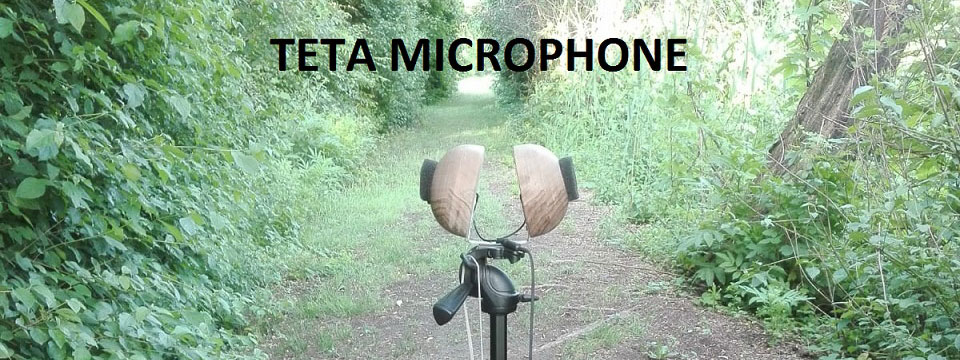TETA MICROPHONE
Reading Time: 4 minutes
Test with a song of Blackcap, for a new stereo microphone system called “TETA”, that allows reception of the stereophonic image to cover fully 360-degree soundscape, a degree that can be varied by rotating the microphone heads to obtain a classic ORTF front stereo image. The capsules are spaced 17 cm from each other.

Looking at the waveform, the difference between the two halves of the file appears clear, with the subject at first positioned decidedly to the left with respect to the microphonic apparatus, then at 3’40” moved a little further to the right than the center.
Here a tested AOM 5024L microphone capsule. This capsule is comparable in size and sound performance to the most known and widespread Primo EM 172 (now EM 272).
The AOL is more sensitive than the Primo capsule, however, in some uses, the lower sensitivity and the higher overload limit of the Primo, 119 dBspl vs 110 dB, allows a larger headroom, e.g. when used in a parabola.
See also: https://www.naturesound.it/2019/08/02/serata-estiva-con-ortotteri/
and: https://www.naturesound.it/2019/08/03/nightingales-duet-song-in-a-marshy-environment/
and here: Grégory Chamming’s GRÉGORY CHAMMING’S TETA MICS RECORDING IN LIMESTONE PLATEAU – FRANCE

For more comfortable portability and use on-the-go, I also built a lightweight version, using an EVA block for Yoga. The half sphere shape was obtained by means of a wood lathe and are rotatable to obtain a degree of angolation that can be varied.



A roosting in my garden. In this MP3 file there is a continuous movement, among the branches but above all in flight, of wood pigeon, cattle egret, gray heron and in the last part of sacred ibis. The movements in flight from one side of the sound stage to the other are clearly perceived (particularly in the last third part of the file). Olympus LS05 recorder, LOW position, max gain on LOW 10/10, 24 bit. TETA microphone with AOM capsules.
It is useless to recommend listening with headphones!
_________________________________________________________________________________________________________
Below, a wonderful recording made in France by Grègory Chamming’s, in Lozère.
Please listen with a good pair of headphones!!!

The scene is located in Lozère, in the “Gorges de la Jonte” France, on a mass grave to feed the Vultures, set up by the LPO (League for the Protection of Birds), in partnership with the local farmers. This day, the microphone “TETA”, is placed at about thirty meters of the “place” of the curse of the birds. The microphone on the right side, towards the birds, the left side towards the cliff above the void, in order to capture particularly, their wing beats, when they leave… The “curée” lasted more than 2 hours, on 4 ewes ! 28-03-22, Roland R26 recorder, light TETA microphone.

________________________
Here Grègory Chamming’s with TETA Microphone and Roland R05 at Carcans-Maubuisson, 33121 (France) two excellent recordings on a group of more than 11600 cranes!!!
28-12-22, Carcans-Maubuisson, 33121 (France), a few hundred meters from the pond of Cousseau, dormitory of cranes, counted at 11620 this year in wintering. Atmosphere of the first flights of Grus Grus, 9h00.

In the background, on the right, the surf of the ocean, 5km away. 1’41” Shotgun blast from a hunter 2’22” Troglodytes troglodytes, in alarm The high-pitched whistles, heard in Grus Grus flights, are the calls of the young of the year. Their “syrinx”, the organ of song, is not yet fully formed, like that of the adults.

Commenti recenti